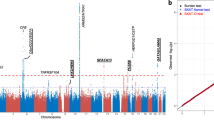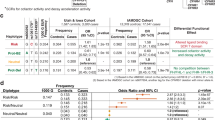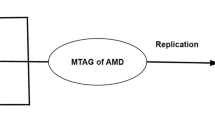Abstract
Purpose
To determine whether there is an association between hepatic lipase (LIPC) and age-related macular degeneration (AMD) in two independent Caucasian cohorts.
Methods
A discovery cohort of 1626 patients with advanced AMD and 859 normal controls and a replication cohort of 2159 cases and 1150 controls were genotyped for two single-nucleotide polymorphisms (SNPs) in the promoter region of LIPC. The associations between the SNPs and AMD were examined by χ2 tests.
Results
In the discovery cohort, rs493258 and rs10468017 were both associated with advanced AMD (P=9.63E−3 and P=0.048, respectively). The association was corroborated in the replication cohort (P=4.48E−03 for rs493258 and P=0.015 for rs10468017). Combined analysis resulted in even more significant associations (P=1.21E−04 for rs493258 and P=1.67E−03 for rs10468017).
Conclusion
The LIPC promoter variants rs493258 and rs10468017 were associated with advanced AMD in two independent Caucasian populations, confirming that LIPC polymorphisms may be a genetic risk factor for AMD in the Caucasian population.
Similar content being viewed by others
Introduction
Age-related macular degeneration (AMD) is the leading cause of irreversible blindness for elderly individuals in the developed world. It is estimated that >9 million people in the United States suffer from intermediate or advanced AMD.1, 2 Depending on the severity, AMD can be classified into two separate stages. Early AMD is characterized by soft drusen and pigmentary changes in the retinal pigment epithelium (RPE). Advanced AMD leads to vision loss and can be further subdivided into geographic atrophy (GA, dry AMD) and choroidal neovascularization (wet AMD). Despite the high prevalence and significant public health burden of AMD, its etiology and pathophysiology remain poorly understood.
AMD is a multi-factorial progressive disease that involves complex interactions between genetic and environmental factors.3, 4 Candidate gene association studies have identified multiple genes related to AMD, including CFH,5, 6 ARMS2/HTRA1,7, 8, 9 C2I,10 and CFB.11 Identification of these genes has led to extensive studies on the alternative complement pathway and mitochondria-related oxidation pathways in relation to AMD.12, 13, 14 Despite significant progress in identifying AMD-associated genes, genetic susceptibility loci discovered thus far only account for approximately half the heritability of AMD.15 Recent studies demonstrated that antioxidant micronutrients and lipids may also have an important role in AMD;16, 17, 18, 19 a genome-wide association study found a significant association between advanced AMD and hepatic lipase (LIPC), the gene encoding hepatic triglyceride lipase.20 In this study, we confirmed the association of LIPC with advanced AMD in two independent Caucasian cohorts.
Materials and methods
Subjects and clinical diagnosis
This study was approved by the Institutional Review Board of the University of California, San Diego, CA, USA. The research adhered to the tenets of the Declaration of Helsinki. Informed consent was signed by all subjects before participation in the study. We certify that all applicable institutional and governmental regulations concerning the ethical use of human volunteers were followed during this research.
In total, 1626 nonfamilial advanced AMD patients and 859 normal age-matched controls (age 50 years or older without drusen or RPE changes) were recruited at the University of California, San Diego, CA, USA. Demographics, medical history, and a blood sample were collected at the baseline visit. All participants underwent standard ophthalmic examinations, including slit lamp exams and indirect ophthalmoscopy. A pair of stereoscopic color fundus photographs (50°) was taken, centered on the fovea using a Topcon fundus camera (Topcon TRV-50VT, Topcon Optical Company, Tokyo, Japan). Grading was carried out using a standard grid classification suggested by the International Age-related Maculopathy Epidemiological Study Group.21 In total, 2159 cases and 1150 controls from the Michigan, Mayo, AREDS, and Pennsylvania data set were included in this study as a replication cohort.
Genotyping
Genomic DNA samples were extracted from peripheral blood leukocytes with the Qiagen kit (Qiagen Inc., Chatsworth, CA, USA), according to the manufacturer’s instructions. The discovery cohort of 1626 advanced AMD patients were genotyped for the LIPC variants rs10468017 and rs493258. Variance and position of the two single-nucleotide polymorphisms (SNPs) are shown in Supplementary Table 1. Allele frequencies were compared with 859 age and ethnicity-matched normal controls by laboratory personnel blinded to case/control status. The findings were tested for replication in an independent cohort of 2159 advanced AMD patients and 1150 controls.
Genotyping of both SNPs was achieved by primer extension of multiplex PCR products followed by SNaPshot on an ABI 3100 genetic analyzer (Applied Biosystems, Foster City, CA, USA). All genotyping results were of high quality, with an average call rate of 98.5%.
Statistical analysis
Deviation from Hardy–Weinberg equilibrium was assessed with a statistical significance level of 0.01. χ2 tests under the additive model were performed to assess evidence for association between the LIPC genotype and advanced AMD between cases and controls. The statistical significance level was adjusted by Bonferroni correction. Odds ratios and 95% confidence intervals were also calculated to estimate risk size of the risk alleles by using SPSS 11.5 software (Chicago, IL, USA). Linkage disequilibrium (LD) patterns were defined by Haploview 4.1 software (Cambridge, MA, USA).
Results
The demographics of the discovery cohort are presented in Table 1. The promoter variant rs493258 was found to be significantly associated with advanced AMD in the discovery cohort (P=9.63E−03), replication cohort (P=4.48E−03), and combined cohort (1.21E−04; Table 2a). For rs10468017, a significant association with advanced AMD was also found in the discovery cohort (P=0.048), replication cohort (P=0.015), as well as the combined cohort (P=1.67E−03; Table 2b).
Overall, the frequency of the minor (A) allele of rs493258 was 43.4% in cases vs 47.1% in controls, whereas the frequency of the minor (T) allele of rs10468017 was 26.7% in cases vs 29.5% in controls. Haplotype analysis did not show strong LD between the two SNPs (r2=0.369). Genotype counts are shown in Supplementary Tables 2a and b.
Discussion
Here, we confirmed the genetic association between AMD and LIPC and expand upon previous reports by analyzing two independent Caucasian populations. Our findings were consistent with previous studies in which both SNPs were reported to be significantly associated with AMD.20, 22
The LIPC gene encodes hepatic triglyceride lipase, which is expressed in the liver. LIPC catalyzes the hydrolysis of phospholipids, mono-, di-, and triglycerides, and acyl-CoA thioesters, and it has an important role in the metabolism of lipoproteins, including high-density lipoprotein (HDL)23, 24, 25 and low-density lipoprotein.26 Previous studies have demonstrated that LIPC is associated with metabolic syndrome,27, 28 atherosclerosis,29, 30 and other cardiovascular disorders.31, 32
The mechanism(s) underlying the relationship between LIPC and AMD is unknown. Despite the association of LIPC and serum HDL levels, the correlation between AMD and serum HDL levels is inconsistent.21, 33 These findings suggest that LIPC may modulate AMD risk through a mechanism independent from its effect on HDL levels. Central to AMD progression is the buildup of cellular debris, proteins, and lipids within Bruch’s membrane, which results in the formation of drusen.34 These changes in Bruch’s membrane result in tissue hypoxia and the production of angiogenic signaling molecules (eg, VEGF) that promote aberrant blood vessel growth.35 In addition, oxidative stress in the eye can cause the oxidation of phospholipids. These oxidation products are pro-inflammatory and can also lead to RPE apoptosis, VEGF production, and angiogenesis.36, 37 As LIPC is an important enzyme in lipid metabolism and has been shown to be related to both the accumulation of drusen and progression from large drusen to advanced AMD,38 it may modulate AMD risk by affecting lipid homeostasis and the accumulation of damaging biomolecules in the eye. Further studies evaluating the role of lipoproteins in the pathogenesis and progression of AMD will elucidate the role of LIPC in AMD and may lead to novel strategies for AMD prevention and treatment.

References
Friedman DS, O’Colmain BJ, Munoz B, Tomany SC, McCarty C, de Jong PT et al. Prevalence of age-related macular degeneration in the United States. Arch Ophthalmol 2004; 122 (4): 564–572.
Cameron DJ, Yang Z, Gibbs D, Chen H, Kaminoh Y, Jorgensen A et al. HTRA1 variant confers similar risks to geographic atrophy and neovascular age-related macular degeneration. Cell Cycle 2007; 6 (9): 1122–1125.
Khan JC, Thurlby DA, Shahid H, Clayton DG, Yates JR, Bradley M et al. Smoking and age related macular degeneration: the number of pack years of cigarette smoking is a major determinant of risk for both geographic atrophy and choroidal neovascularisation. Br J Ophthalmol 2006; 90 (1): 75–80.
Seddon JM, Santangelo SL, Book K, Chong S, Cote J . A genomewide scan for age-related macular degeneration provides evidence for linkage to several chromosomal regions. Am J Hum Genet 2003; 73 (4): 780–790.
Hageman GS, Anderson DH, Johnson LV, Hancox LS, Taiber AJ, Hardisty LI et al. A common haplotype in the complement regulatory gene factor H (HF1/CFH) predisposes individuals to age-related macular degeneration. Proc Natl Acad Sci USA 2005; 102 (20): 7227–7232.
Brantley MA, Fang AM, King JM, Tewari A, Kymes SM, Shiels A . Association of complement factor H and LOC387715 genotypes with response of exudative age-related macular degeneration to intravitreal bevacizumab. Ophthalmology 2007; 114 (12): 2168–2173.
Yang Z, Camp NJ, Sun H, Tong Z, Gibbs D, Cameron DJ et al. A variant of the HTRA1 gene increases susceptibility to age-related macular degeneration. Science 2006; 314 (5801): 992–993.
Dewan A, Liu M, Hartman S, Zhang SS, Liu DT, Zhao C et al. HTRA1 promoter polymorphism in wet age-related macular degeneration. Science 2006; 314 (5801): 989–992.
Andreoli MT, Morrison MA, Kim BJ, Chen L, Adams SM, Miller JW et al. Comprehensive analysis of complement factor H and LOC387715/ARMS2/HTRA1 variants with respect to phenotype in advanced age-related macular degeneration. Am J Ophthalmol 2009; 148 (6): 869–874.
Gold B, Merriam JE, Zernant J, Hancox LS, Taiber AJ, Gehrs K et al. Variation in factor B (BF) and complement component 2 (C2) genes is associated with age-related macular degeneration. Nat Genet 2006; 38 (4): 458–462.
Kaur I, Katta S, Reddy R, Narayanan R, Mathai A, Majji AB et al. The involvement of complement factor B and complement component C2 in an Indian cohort with age-related macular degeneration. Invest Ophthalmol Vis Sci 2010; 51 (1): 59–63.
Klein RJ, Zeiss C, Chew EY, Tsai JY, Sackler RS, Haynes C et al. Complement factor H polymorphism in age-related macular degeneration. Science 2005; 308 (5720): 385–389.
Edwards AO, Ritter R, Abel KJ, Manning A, Panhuysen C, Farrer LA . Complement factor H polymorphism and age-related macular degeneration. Science 2005; 308 (5720): 421–424.
Kanda A, Chen W, Othman M, Branham KE, Brooks M, Khanna R et al. A variant of mitochondrial protein LOC387715/ARMS2, not HTRA1, is strongly associated with age-related macular degeneration. Proc Natl Acad Sci USA 2007; 104 (41): 16227–16232.
Maller J, George S, Purcell S, Fagerness J, Altshuler D, Daly MJ et al. Common variation in three genes, including a noncoding variant in CFH, strongly influences risk of age-related macular degeneration. Nat Genet 2006; 38 (9): 1055–1059.
SanGiovanni JP, Chew EY, Clemons TE, Davis MD, Ferris FL, Gensler GR et al. The relationship of dietary lipid intake and age-related macular degeneration in a case-control study: AREDS report no. 20. Arch Ophthalmol 2007; 125 (5): 671–679.
Fletcher AE, Bentham GC, Agnew M, Young IS, Augood C, Chakravarthy U et al. Sunlight exposure, antioxidants, and age-related macular degeneration. Arch Ophthalmol 2008; 126 (10): 1396–1403.
Seddon JM, Cote J, Rosner B . Progression of age-related macular degeneration: association with dietary fat, transunsaturated fat, nuts, and fish intake. Arch Ophthalmol 2003; 121 (12): 1728–1737.
Yu AL, Lorenz RL, Haritoglou C, Kampik A, Welge-Lussen U . Biological effects of native and oxidized low-density lipoproteins in cultured human retinal pigment epithelial cells. Exp Eye Res 2009; 88 (3): 495–503.
Neale BM, Fagerness J, Reynolds R, Sobrin L, Parker M, Raychaudhuri S et al. Genome-wide association study of advanced age-related macular degeneration identifies a role of the hepatic lipase gene (LIPC). Proc Natl Acad Sci USA 2010; 107 (16): 7395–7400.
Bird AC, Bressler NM, Bressler SB, Chisholm IH, Coscas G, Davis MD et al. An international classification and grading system for age-related maculopathy and age-related macular degeneration. The International ARM Epidemiological Study Group. Surv Ophthalmol 1995; 39 (5): 367–374.
Chen W, Stambolian D, Edwards AO, Branham KE, Othman M, Jakobsdottir J et al. Genetic variants near TIMP3 and high-density lipoprotein-associated loci influence susceptibility to age-related macular degeneration. Proc Natl Acad Sci USA 2010; 107 (16): 7401–7406.
Santamarina-Fojo S, Gonzalez-Navarro H, Freeman L, Wagner E, Nong Z . Hepatic lipase, lipoprotein metabolism, and atherogenesis. Arterioscler Thromb Vasc Biol 2004; 24 (10): 1750–1754.
Feitosa MF, Myers RH, Pankow JS, Province MA, Borecki IB . LIPC variants in the promoter and intron 1 modify HDL-C levels in a sex-specific fashion. Atherosclerosis 2009; 204 (1): 171–177.
Knoblauch H, Bauerfeind A, Toliat MR, Becker C, Luganskaja T, Gunther UP et al. Haplotypes and SNPs in 13 lipid-relevant genes explain most of the genetic variance in high-density lipoprotein and low-density lipoprotein cholesterol. Hum Mol Genet 2004; 13 (10): 993–1004.
Chamberlain AM, Folsom AR, Schreiner PJ, Boerwinkle E, Ballantyne CM . Low-density lipoprotein and high-density lipoprotein cholesterol levels in relation to genetic polymorphisms and menopausal status: the Atherosclerosis Risk in Communities (ARIC) Study. Atherosclerosis 2008; 200 (2): 322–328.
McCarthy JJ, Meyer J, Moliterno DJ, Newby LK, Rogers WJ, Topol EJ . Evidence for substantial effect modification by gender in a large-scale genetic association study of the metabolic syndrome among coronary heart disease patients. Hum Genet 2003; 114 (1): 87–98.
Stancakova A, Baldaufova L, Javorsky M, Kozarova M, Salagovic J, Tkac I . Effect of gene polymorphisms on lipoprotein levels in patients with dyslipidemia of metabolic syndrome. Physiol Res 2006; 55 (5): 483–490.
Chen SN, Cilingiroglu M, Todd J, Lombardi R, Willerson JT, Gotto AM et alJr. Candidate genetic analysis of plasma high-density lipoprotein-cholesterol and severity of coronary atherosclerosis. BMC Med Genet 2009; 10: 111.
Eifert S, Rasch A, Beiras-Fernandez A, Nollert G, Reichart B, Lohse P . Gene polymorphisms in APOE, NOS3, and LIPC genes may be risk factors for cardiac adverse events after primary CABG. J Cardiothorac Surg 2009; 4: 46.
Hindorff LA, Lemaitre RN, Smith NL, Bis JC, Marciante KD, Rice KM et al. Common genetic variation in six lipid-related and statin-related genes, statin use and risk of incident nonfatal myocardial infarction and stroke. Pharmacogenet Genomics 2008; 18 (8): 677–682.
Valdivielso P, Ariza MJ, de la Vega-Roman C, Gonzalez-Alegre T, Rioja J, Ulzurrun E et al. Association of the -250 G/A promoter polymorphism of the hepatic lipase gene with the risk of peripheral arterial disease in type 2 diabetic patients. J Diabetes Complications 2008; 22 (4): 273–277.
Reynolds R, Rosner B, Seddon JM . Serum lipid biomarkers and hepatic lipase gene associations with age-related macular degeneration. Ophthalmology 2010; 117 (10): 1989–1995.
Abdelsalam A, Del Priore L, Zarbin MA . Drusen in age-related macular degeneration: pathogenesis, natural course, and laser photocoagulation-induced regression. Surv Ophthalmol 1999; 44 (1): 1–29.
Starita C, Hussain AA, Patmore A, Marshall J . Localization of the site of major resistance to fluid transport in Bruch's membrane. Invest Ophthalmol Vis Sci 1997; 38 (3): 762–767.
Curcio CA, Johnson M, Huang JD, Rudolf M . Apolipoprotein B-containing lipoproteins in retinal aging and age-related macular degeneration. J Lipid Res 2010; 51 (3): 451–467.
Weismann D, Hartvigsen K, Lauer N, Bennett KL, Scholl HP, Charbel Issa P et al. Complement factor H binds malondialdehyde epitopes and protects from oxidative stress. Nature 2011; 478 (7367): 76–81.
Yu Y, Reynolds R, Rosner B, Daly MJ, Seddon JM . Prospective assessment of genetic effects on progression to different stages of age-related macular degeneration using multistate Markov models. Invest Ophthalmol Vis Sci 2012; 53 (3): 1548–1556.
Acknowledgements
We thank Chao Zhao, Kevin Wang, Daniel Kasuga, and Jean Guan for their assistance with this study. We also thank all the participating AMD patients and their families. This study is supported by 973 Program (2011CB510200, 2013CB967504); Genentech, NEI/NIH (Bethesda), KACST -UCSD Center of Excellence in Nanomedicine, Research to Prevent Blindness (New York), and VA Merit Award (San Diego).
Author information
Authors and Affiliations
Corresponding author
Ethics declarations
Competing interests
The authors declare no conflict of interest.
Additional information
Supplementary Information accompanies this paper on Eye website
Supplementary information
Rights and permissions
About this article
Cite this article
Lee, J., Zeng, J., Hughes, G. et al. Association of LIPC and advanced age-related macular degeneration. Eye 27, 265–271 (2013). https://doi.org/10.1038/eye.2012.276
Received:
Accepted:
Published:
Issue Date:
DOI: https://doi.org/10.1038/eye.2012.276
Keywords
This article is cited by
-
CETP/LPL/LIPC gene polymorphisms and susceptibility to age-related macular degeneration
Scientific Reports (2015)



